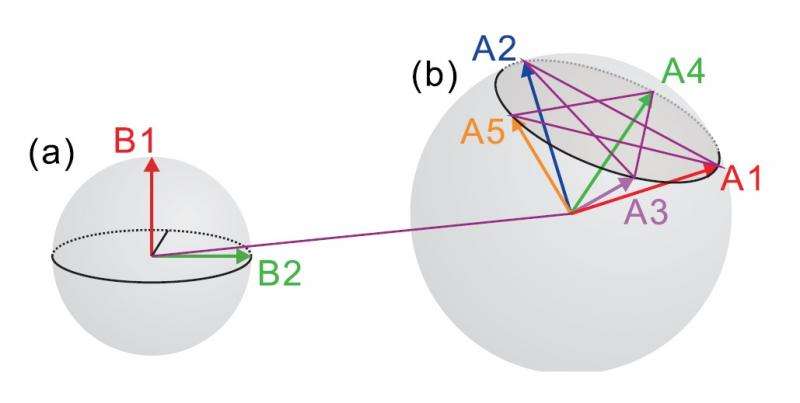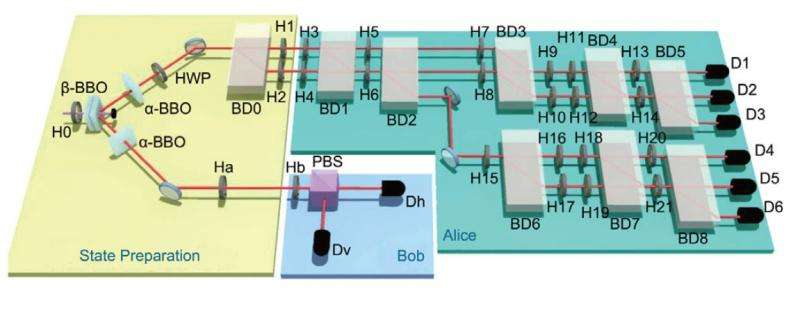March 21, 2016 feature
Two defining features of quantum mechanics never appear together

(Phys.org)—Two of the most important ideas that distinguish the quantum world from the classical one are nonlocality and contextuality. Previously, physicists have theoretically shown that both of these phenomena cannot simultaneously exist in a quantum system, as they are both just different manifestations of a more fundamental concept, the assumption of realism. Now in a new paper, physicists have for the first time experimentally confirmed that these two defining features of quantum mechanics never appear together.
The physicists, Xiang Zhan, et al., have published a paper on the nonlocality-contextuality tradeoff in a recent issue of Physical Review Letters.
In the everyday world that we observe, an object can only be affected by nearby objects (locality), and when we make a measurement, the outcome does not depend on other independent measurements being made at the same time (noncontextuality).
In contrast, the quantum world is nonlocal, as demonstrated by quantum entanglement where two objects can influence each other even when separated by large distances. And in the quantum world, measurements are contextual, so quantum systems do not have predetermined values but instead their values depend on how measurements are made.
To show that a quantum system is nonlocal or contextual, physicists have defined inequalities that assume a system is the opposite (local or noncontextual). Then they perform experiments that attempt to violate these inequalities to show that the system is not local or noncontextual. So far, these two types of inequalities have never been tested simultaneously.

In the new study, the researchers have attempted to violate both inequalities at the same time, but have found that only one inequality can be violated at once. Their experiment uses entangled photons to generate photonic qutrit-qubit systems (a qubit is a superposition of two states, whereas a qutrit is a superposition of three states). By performing various measurements on these photons, the researchers could violate the inequalities separately, but not at the same time.
"The greatest significance of our work is that we provide experimental evidence of the assumption that quantum entanglement and contextuality are intertwined quantum resources," Peng Xue, a physicist at Southeast University in Nanjing, China, and one of the lead authors of the paper, told Phys.org.
As the physicists explain, the reason for the nonlocality-contextuality tradeoff arises from the fact that both properties have the same root: the assumption of realism, which is the assumption that the physical world exists independent of our observations, and that the act of observation does not change it.
Since nonlocality and contextuality can be thought of as two different manifestations of the basic assumption of realism, then one of them can be transformed into the other, but both cannot exist at the same time because they are essentially the same thing.
"We think the contextuality-nonlocality monogamy suggests the existence of a quantum resource of which entanglement is just a particular form," Xue said. "The resource required to violate the noncontextuality inequality and that required to violate the locality inequality are fungible through entanglement. That is, to violate the locality inequality costs entanglement as a resource, while to violate the noncontextuality inequality costs contextuality as a resource. In a quantum system, only one of the two inequalities can be violated because nothing is left to violate the other one."
The researchers hope that the new experiment will open the doors to further exploring the mutual resource in the future, as well as lead to potential applications.
"We plan to study contextuality as a resource for experimental quantum information processing, such as for quantum computation," Xue said.
More information: Xiang Zhan, et al. "Realization of the Contextuality-Nonlocality Tradeoff with a Qubit-Qutrit Photon Pair." Physical Review Letters. DOI: 10.1103/PhysRevLett.116.090401
Journal information: Physical Review Letters
© 2016 Phys.org




















